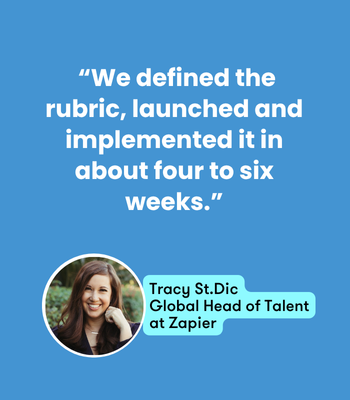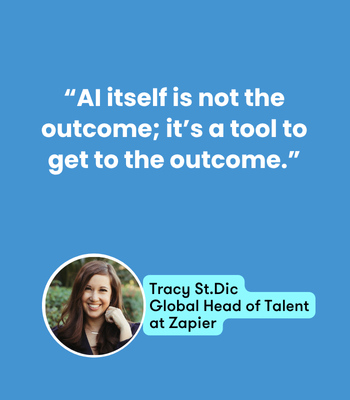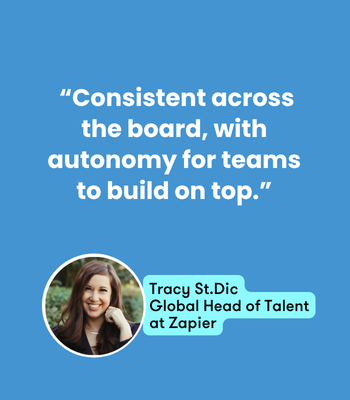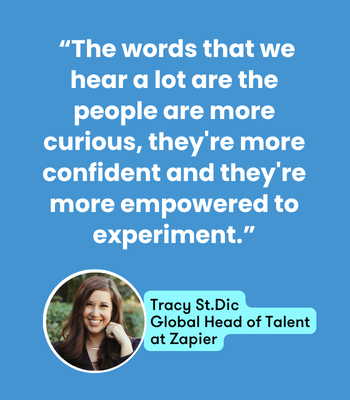From ‘AI bar’ to day 1 impact: AI fluency with Tracy St.Dic
22nd Oct 2025
This is the second feature in Pivotal’s AI Fluency Series, where we speak with leaders putting AI capability to work in real teams. In this conversation, Tracy St.Dic, Global Head of Talent at Zapier, explains how the company built its successful AI Fluency framework, embedded it across the hiring funnel, and what’s changed since.
You’ve built one of the most practical frameworks I’ve seen for assessing AI capability. When did the idea to formalise that bar first take shape at Zapier, and how quickly did you bring it to life?
Tracy: We started this process end of April or beginning of May… and we were able to define the rubric, launch and implement it in about four to six weeks.
That’s fast. What tipped it from “discussion” to “let’s ship it”?
Tracy: We’d been looking at it since 2023, should we have an AI fluency bar? Back then ChatGPT was still fairly new, and executives were a little bit hesitant… how do you define it, it’s going to change. Going into the spring, when we understood how it needed to show up in the candidate experience and assessment, we said: now is the time. Draw a line in the sand. Use shared language so we can assess it.

Zapier now calls itself AI-first. What does that mean day-to-day?
Tracy: Zapier started as an automation platform; now we’re an AI orchestration platform. We are absolutely AI first, not just internally to make ourselves more efficient, but because we also want to be a model for our customers. We dog-food our own products… we need to be skilled in AI orchestration so we can say: here are our use cases; here’s a template; we use it internally, here you go as well.
How does that philosophy show up in hiring?
Tracy: We embed AI fluency in four places: at the application (optional question), at the recruiter screen (specific question), at a department-specific skills test, and in the executive interview at the very end.
So you’re not just checking for AI fluency once, you’re tracking how candidates, and later employees, build on those skills over time?
Tracy: We measure three things: AI mindset; AI strategy or strategic acumen, our CPO calls it “the craft,” understanding the future of AI in your function; and builder/technical skills. We also look at how people grow throughout the interview process. If someone seems awesome in baseline skills but isn’t as fluent yet, we suggest resources and see how they learn and experiment. We’re looking at the curve, not the snapshot.
What does fluency in action look like in interviews?
Tracy: We try to understand the how, when and why they use AI, not just if they’ve done it. AI itself is not the outcome; it’s a tool to get to the outcome. We dig into how they’ve improved their own workflows and created leverage. A marketer might walk us through a content workflow they automated using Zapier and AI. We also include open-ended questions about how they’d apply AI in the role.
Knowing when not to use AI and when there should be a human in the loop is equally important. We assess whether people have a mature view: here’s where we should use it, here’s where we shouldn’t, and here’s why that might change over time.

Let’s unpack your levels: Unacceptable, Capable, Adoptive, Transformative. What lives in each?
Tracy: Unacceptable is people who are sceptical, who don’t want to use it, or aren’t curious about it. Also, people using it without any purpose. Capable is the minimum baseline: using it purposefully for your own work, feeling comfortable with tools, and articulating the time saved and the reasons. Adoptive is building workflows for yourself – automated or AI-assisted – changing the way you work and potentially scaling to others or your team. Transformative is: I have transformed my work, and it is different now. If you pulled the AI out of their work, everything would crumble. They’re also thinking about the future of their function.
Most companies are stuck in the efficiency phase, saving hours here and there.
Tracy: That’s where most companies are today: save a few hours, which adds up, maybe 10 hours a week. Transformative is questioning how and why you do certain things and how you can do them almost entirely or mostly with AI. It’s a very different mindset from adoptive.
Why standardise this across such different functions?
Tracy: We needed a shared language. Executives and hiring managers were all over the place with how they were assessing it. This gives us a way to assess the skill and understand the impact on work.
Rolling this out across a big org sounds non-trivial. How did you do it in 4-6 weeks?
Tracy: I started with the executive team and asked each exec: what does AI fluency mean to you; what would you want to see? We brought that together and created the rubric, so they were invested. From a change-management perspective, we calibrated the smallest groups first: recruiters (training, quick quiz, Loom videos) and executives (already part of the creation and feedback loops). That made consistency much easier.
What about assessments, how do you avoid “one-size-fits-none”?
Tracy: We created a default technical skills test with engineering leaders, and default non-technical tests for roles like tax, people, finance, biz ops, manager and IC versions. Baselines you can build on. It’s consistent across the board, with autonomy for teams like marketing to layer in subject-matter specifics and calibrate interviewers.

Is “Unacceptable” a hard bar?
Tracy: We have rejected candidates who would be on the Unacceptable level, absolutely. Sometimes people “hit Capable” because their company told them how to use AI and they just execute. We dig into their own inclination. We have rejected people for that reason.
What’s changed since launch?
Tracy: We implemented at the beginning of June. It’s early, but we’re seeing interesting things. In a quick study, hiring managers said folks who came in as Capable moved toward Adoptive through onboarding. And in at least three cases where someone came in really strong on AI fluency, managers described a transformational impact within two or three months.
And culturally?
Tracy: The words we hear a lot are: more curious, more confident, more empowered to experiment. That’s exactly what we wanted. Our product is constantly evolving, we need people ready to keep learning how to use it.

Pivotal have a large marketing audience, can you ground this in marketing examples?
Tracy: I pulled up the marketing examples we published. Capable: summarising customer stories; drafting first drafts of social posts or headlines with AI, then editing by hand. Adoptive: running a basic AI stack and A/B test to increase CTR. Transformative: building an entirely AI-driven campaign engine to personalise content at scale. Marketing is one of the functions where we hold a very high bar for AI fluency.
If another company wants to build its own framework, where should they start?
Tracy: Start with the why and the philosophy – keep it simple. Use real language, keep it concrete, and build it into hiring moments that already exist. Tie it to mission and outcomes. Where it makes sense, weave this in and start to get the data.
And lastly, how do you future proof your framework when AI is constantly evolving?
Tracy: We designed it to evolve. Ship it when it’s 80% ready, knowing it will evolve. We reevaluate every three to six months; we may raise the bar; we update tools, prompts and assessments regularly. If we build it for adaptability, we’ll be ready for whatever’s next.
Zapier’s approach shows what happens when AI fluency stops being abstract and becomes part of the funnel, onboarding and day-to-day work. If you want to raise the bar in your own organisation, our AI Fluency Hiring Frameworks give you the building blocks to assess, and develop, AI-confident teams. Get the frameworks here.